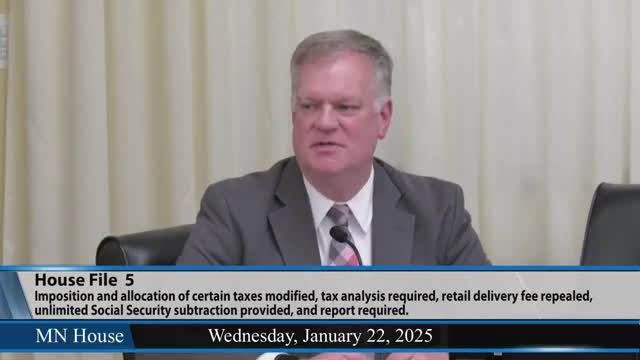Minnesota lawmakers consider repealing controversial retail delivery fee amid small business concerns
January 22, 2025 | 2025 Legislature MN, Minnesota
This article was created by AI summarizing key points discussed. AI makes mistakes, so for full details and context, please refer to the video of the full meeting. Please report any errors so we can fix them. Report an error »

In a recent meeting of the Minnesota House Transportation Finance and Policy Committee, lawmakers discussed the implications of HF5, a bill aimed at repealing the controversial retail delivery fee imposed on deliveries from services like Amazon and Uber Eats. This fee, introduced in 2023, charges consumers 50 cents on orders exceeding $100. The committee heard from various stakeholders, including small business representatives and economists, who expressed concerns about the fee's impact on both businesses and consumers.
John Phelan, an economist from the Center of the American Experiment, highlighted that while state and local governments face challenges in funding road maintenance, delivery fees are not an effective solution. He pointed out that traditional funding sources, such as the motor fuels tax, have been under pressure due to inflation, improved fuel economy, and the rise of electric vehicles (EVs). These factors have led to a decrease in gas tax revenues, which are crucial for road upkeep.
Small business representatives echoed Phelan's sentiments, noting that many businesses struggle to collect the delivery fee, ultimately absorbing the costs themselves. This situation not only affects their bottom line but also limits their ability to invest in their operations and pay employees. The committee members acknowledged the growing dissatisfaction with the delivery fee, which has become increasingly unpopular among small businesses and consumers alike.
The discussion also touched on the broader implications of the increasing number of electric vehicles on Minnesota's roads. With a significant rise in EV registrations, Phelan pointed out that these vehicles contribute to road wear and tear without paying an equivalent share of gas taxes. This discrepancy could lead to further budgetary pressures as the state aims to increase the number of EVs on the road.
As the committee deliberates on HF5, the potential repeal of the retail delivery fee could signal a shift in how Minnesota approaches funding for transportation infrastructure. The discussions reflect a growing recognition of the need for more sustainable and equitable funding solutions that address the evolving landscape of transportation in the state. The committee's next steps will be crucial in determining how Minnesota balances the needs of its infrastructure with the financial realities faced by consumers and businesses.
John Phelan, an economist from the Center of the American Experiment, highlighted that while state and local governments face challenges in funding road maintenance, delivery fees are not an effective solution. He pointed out that traditional funding sources, such as the motor fuels tax, have been under pressure due to inflation, improved fuel economy, and the rise of electric vehicles (EVs). These factors have led to a decrease in gas tax revenues, which are crucial for road upkeep.
Small business representatives echoed Phelan's sentiments, noting that many businesses struggle to collect the delivery fee, ultimately absorbing the costs themselves. This situation not only affects their bottom line but also limits their ability to invest in their operations and pay employees. The committee members acknowledged the growing dissatisfaction with the delivery fee, which has become increasingly unpopular among small businesses and consumers alike.
The discussion also touched on the broader implications of the increasing number of electric vehicles on Minnesota's roads. With a significant rise in EV registrations, Phelan pointed out that these vehicles contribute to road wear and tear without paying an equivalent share of gas taxes. This discrepancy could lead to further budgetary pressures as the state aims to increase the number of EVs on the road.
As the committee deliberates on HF5, the potential repeal of the retail delivery fee could signal a shift in how Minnesota approaches funding for transportation infrastructure. The discussions reflect a growing recognition of the need for more sustainable and equitable funding solutions that address the evolving landscape of transportation in the state. The committee's next steps will be crucial in determining how Minnesota balances the needs of its infrastructure with the financial realities faced by consumers and businesses.
View full meeting
This article is based on a recent meeting—watch the full video and explore the complete transcript for deeper insights into the discussion.
View full meeting
